Recognizing and Realization of Stable Identity, Values and Philosophy of Islamic Art in the Creation of Architectural Excellence
Omid Azari1 *
1
Islamic Azad University of Karaj,
Iran
Corresponding author Email: Arturazeri77@yahoo.com
DOI: http://dx.doi.org/10.12944/CWE.10.Special-Issue1.118
Various aspects of Islamic art, such as architecture have common principles that are current in their structure, concepts and components. These principles which are derived from knowledge and Islamic wisdom, associated with all aspects of Islamic architecture and is part of its identity. An identity that for modern architecture due to the influx of modernity of the West, has faded. The purpose of this study is to understand some of the principles and concepts of the structure of Iranian-Islamic art through the comparative study of wisdom existence in architecture so that with this way, can be searched the lost identity of Islamic architecture. So far various definitions have been proposed in order to explain the Islamic architecture that often considered material and appearance aspect of the subject. While the ruling attitude to Islamic architecture, In fact is a vision-inducing attitude and can provide the redefined leading Islamic architecture. This research proposed ruling approach for Islamic Architecture which it has used systematic method with normative structure and investigated the needs of made belong to identity of original architecture in the form of wisdom and Islamic art. Accordingly, after the evaluating principles of the wisdom of Islamic art and its theoretical and practical content and principles governing in theoretical and practical propositions and has been studied the effects of art wisdom, Insolubility, dynamics and manifestation of wisdom art in Islamic architecture and then with redrawing of new horizon, it has been evaluated the method of realization of wisdom identity and Islamic art in the creation of architectural excellence as main objective of research.
Copy the following to cite this article:
Azari O. Recognizing and Realization of Stable Identity, Values and Philosophy of Islamic Art in the Creation of Architectural Excellence. Special Issue of Curr World Environ 2015;10(Special Issue May 2015). DOI:http://dx.doi.org/10.12944/CWE.10.Special-Issue1.118
Copy the following to cite this URL:
Azari O. Recognizing and Realization of Stable Identity, Values and Philosophy of Islamic Art in the Creation of Architectural Excellence. Special Issue of Curr World Environ 2015;10(Special Issue May 2015). Available from: http://www.cwejournal.org/?p=11
Download article (pdf)
Citation Manager
Publish History
Select type of program for download
| Endnote EndNote format (Mac & Win) | |
| Reference Manager Ris format (Win only) | |
| Procite Ris format (Win only) | |
| Medlars Format | |
| RefWorks Format RefWorks format (Mac & Win) | |
| BibTex Format BibTex format (Mac & Win) |
Article Publishing History
| Received: | 2015-03-15 |
|---|---|
| Accepted: | 2015-04-20 |
Introduction
The result of the art masters and ancestors' centuries of experience in this land is the monuments which are referred to as "Iranian Islamic architecture" at present time. The identity crisis and the increasing irregularities in the face of contemporary cities and buildings manifest the value lies in our ancients' experience more than ever before. The historical separation of the contemporary era from the achievements evolution of architectural pioneers produces an unintelligible environment in the contemporary cities. This unintelligibility advanced in the way that there is no logical relation with the old architecture in present day. Being that much opposed to our contemporary architecture, it seems that the Iranian architectural masterpieces have been built elsewhere and have been established by non-Iranians. On the other side, our contemporary architecture is deprived of our fathers' eternal heritages preparedness and glory to the degree as if the buildings' design language is incomprehensible to us. After the dominance of modern culture and Iranian artists' lethargy, a new era is depicted in the art. In this era, the Iranian and Islamic artists and intellectuals attempt to revitalize their Islamic identity with all their power to re-establish their glorious days. The induction of hidden spiritual doctrine of Islamic art and architecture is considered to be one the most basic steps in this field. The doctrine of past era can be a lantern for a lively and active future.
The wisdom of the Islamic architecture is among the main issues which has been paid less attention in the recent period and has been largely ignored in the management and scientific community. With the notion that there is no practical relationship between the wisdom of Islamic architecture and the building design process of Islamic Architecture, a group has attempted to interpret it limited to stories and proverbs quoted by predecessors. A wise attitude toward the architecture is the issue beginning in the first step of the design process. Before entering into such an environment, the architect spirit needs to be integrated with the wisdom and spiritual concepts. The gate to wisdom of Islamic architecture is preceded by the home of the conviction and commitment to doctrines which, although much time has passed since their formation, remained eternal in a dynamic process to the present day. This study is an attempt to clarify the role of spirituality and spiritual behavior of the Islamic culture teachers in terms of a wise look at the meaning of Islamic architecture.
One of the issues related to the philosophy of art which reached a general agreement in recent years is the similarities between religion and art and that the both domains are related to the Transcendent. According to some intellectuals, some of our artistic examples are the expression of wisdom like the architecture of mosques or the direct expression of mysticism and this wisdom objectification can be through music (The Holy Quran).
They believe in the concrete manifestation of Islam in some works of architecture and urbanism of schools such as the Isfahan School. They believe that the architectural works of these schools are generated from a process leading to the manifestation of Islamic thought, especially Shia, in the context of Iranians years of experience in the best way (Avani, 1995). Therefore, according to this view, the body of Islamic architectural works (works apparent plan), is the concrete manifestation of the hidden plan which is equivalent to the content and the heart. These two plans, while being independence, are fully compatible with each other (Nasr, 1990). Some others believe in the complete separation of Islam from Islamic period art and architecture. They emphasize that the form and the body of Islamic architecture are the results of the physical laws, the climatic characteristics, the customs and the physical practices relating to their buildings (Issues, 2008). According to these thinkers, there is no relationship between the Islamic art and the Islamic beliefs (Kuhnel, 1966). It can be said that the Islamic architecture is the outcome of Islamic countries architects' comprehensive efforts (Grabar, 1993) even if the produced goods do not serve Islamic ideals (Michel, 1984). This means that, in this approach, what is referred to as Islamic has no relationship with Islam and the visual forms and the common characteristics of the buildings are investigated as the people same taste (Kosh, 1995). Therefore, this approach considers the definition range of Islamic art and architecture to include the buildings and monuments which have been established in the era of Muslim rulers' dominance (Mahdavinejad, 2003). It excludes the works which are captured by Islamic principles. In other words, this approach seeks to interpret the Islamic monuments with the help of the land characteristics. It considers the Islamic spiritual and wise concepts as an abortive attempt to show the primary and simple buildings as being sacred. According to this approach, they don’t have any holiness (Wilber,1995) .
Based on the discussions, in the present paper, the foundations of Islamic art wisdom and its theoretical and practical content have been evaluated and the principles governing the theoretical and practical statements and the wisdom works of art have been reviewed. Then, the durability, dynamicity and manifestation of the wisdom of art have been studied and, by redrawing the new horizons, the realization of Islamic art and wisdom identity in the creation of the enlightening architectural work has been appeared as the main objective of this research.
Wisdom of Islamic Art
The wisdom of Islamic architecture is a stage in which the human material and spiritual needs are crystallized in a dynamic equilibrium. The human norms and the divine doctrines reach the highest degree of compatibility at a point and a work of art responds equally to the material and spiritual needs at this point. To explain the concept of wisdom in Islamic culture, Hossein Nasr writes that "with these definitions, which Mulla Sadra has presented in Rasa'il, wisdom is a pure rational knowledge which changes its knower in the process of gaining knowledge in a way that his spirit acts like a mirror reflecting the cosmic hierarchy" (Wilber,1995). This stage which was called the wisdom status by Mulla Sadra is a stage in which the human deserves creating the architecture or any other work of art. All his creations are full of clear and appropriate responses to the material demands and spiritual needs. Islamic architecture is the result of spirituality flourished by Islamic architects pure thought to the point that it gained the highest level of prosperity and preparedness in the Isfahan school. This status can be referred to as the crystallization of the wisdom of Islamic architecture. The wisdom of Islamic architecture led to the institutionalization of a tradition which converts the architectural works of the period to the stable and eternal monuments (Avani, 1995).
What are called the Iranian Islamic architecture in present day are the remains of a tradition which could manifest the pure Islamic wisdom in the material body of apparent world through symbolic and sign language by relying on the spiritual doctrines [8]. Believing in any theory of art, it cannot be ignored that, in art, something comes out of the hidden place and has been illustrated from the conscience. If this process does not realize, no form of art does not have to be actualized. Without this emergence, there is nothing as artistic action. There will be no meaning in the art, the work of art, the artist and the artistry (Nasr, 2006). Religious art is the aesthetic experience of the exalted and sacred matter which is sent from the realm beyond the matter and the sky (Rabie, 2008).
In Islam, spirituality and wisdom are inseparable and they are different aspects of a same reality. The wisdom based on which the Islamic art is fixed is nothing but the intellectual aspect of Islamic spirituality. According to Thomas Aquinas, art is nothing without wisdom." Islamic art is essentially other than Muslim art. Islamic art is something in which there is a constructive element of Islamic thought. It means that there should be something of Islam and Islamic thought in its art form not only in its content." This art is based on the esoteric science and observes their inner truth. Islamic art manifests the objects reality of hidden treasures in the realm of corporality through this knowledge and Mohammedan benediction (rahnavard, 1998) ". Generally, apart from the religious-philosophical and mystical thinkers who believe definitely and unquestionably in the sacred and transcendent nature of Islamic art and Islamic art wisdom, most of intellectuals have four approaches to Islamic art as follows;
- impersonal approach of Islamic Art: Guenon, Burckhardt and other intellectuals have spoken about it. They have ruled out any personal motivation for the creation of Islamic art and warned the audience of the individual and private emotions harm of the art. In view of these thinkers, emotional or personal incentives prevent the direct attention to God. According to Burckhardt, Islamic art is based on the fundamental facts which are expressed by a range of organized words and there is monotheism (Unity of God) in the center of these words. In fact, in his view, the Islamic art is the impersonal aesthetic experience of unity and multiplicity of the world. In this experiment, all multiplicity becomes unity in the domain of novel regularity (Rabie, 2008).
- The second approach is based on the first approach and inspired by the sacred origin and destination of Islamic art. Thinkers believe that the subject of Islamic art is exclusively the sacred and divine realm. Therefore, the other topics, the concrete life themes and even the journey from concrete issues to achieve the sacred realm cannot be the theme of Islamic art. In fact, the direct relationship between man and God is the theme of the sacred Islamic art and no other relationships, even if the nature of these relations is toward him (God). The sacred matter implies the superior worlds' manifestation in the sensual and material realms of existence. The origin of the sacred matter is the spiritual science which is beyond the mental realm or world of ego." Burckhardt insists on symbolic expression of sacred art in an exaggerated manner and considers symbolic expression as the essence and the nature of the sacred art. According to him, the art is sacred if it is the story teller of the divine secrets and the symbolic, ironic and allegorical reflection of divine creation. Due to this secret tendency, the sacred art cannot be nature-oriented. It reveals the divine nature of objects as they are. Hence, in the sacred art, the divine spirit mode of action should be the model and it is not possible without codes and symbols." (Rabie, 2008).
- The third approach is related to the concept of time. From the perspective of these intellectuals, Islamic art is sacred and beyond time while other arts belong to time and have its mortal features. The sacred Islamic art is so that it cannot withstand the scheduling
- The fourth approach is the aesthetic expression of sacred art based on abstractive code and symbolization. Although the code and the symbol are agreed by all intellectuals, abstract and figurative actin is disputed from their point of view.
The Theoretical and Practical Wisdom of Islamic art
Practically, each artistic process consists of three dimensions of the artists' ideas and ideals, its scientific methods and procedures (styles) and the instances of works of art. According to the total discussions about the Islamic wisdom, it is concluded that the principles governing the above mentioned three areas (theoretical propositions, practical propositions and instances) must be separated as follows. The theoretical propositions are definitively proven true knowledge which is reasonable and independent of time and place. They are fulfilled without human will and the power of choice. Human beings should hear the views of different schools through a painstaking research without any prejudice to reach the real and non-real diagnosis. The practical propositions (methods and styles to create works of art) are multidimensional. It means that they are general and factual propositions in terms of the origin and source based on artists and architects ideas and ideals. These practical propositions are credit and relative propositions when the artist thinks about his ideas realization considering the overall conditions of time and place and seeks the scientific solutions. These kinds of propositions are obviously based on natural elements and components' constraints and justice (to be fitted and appropriate) governs the executive methods of artwork creation. As a result, it can be said that the scientific statements and artistic styles have an interstitial property. It means that they are factual propositions in terms of origin and artists' idea and they are credit and relative propositions after selecting the style and executive methods. Instances of artwork are based on the theoretical origin and the artists' idea. They are credit, relative and changing and detailed or polysemic propositions which depend on the conditions of time and place.
Therefore, in this article, on the basis of the Islamic attitude, there is a separation between theoretical propositions, practical propositions and instances. Otherwise, there would be no stability for intellectual issues and all of them must be considered relative (Noghrekar, 2007). The details of this separation can be seen in Figure 1.
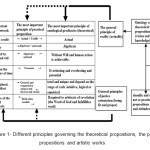 |
Figure 1: Different principles governing the theoretical propositions, the practical propositions and artistic works Click here to View figure |
Persistence of Islamic Art
The simple investigation of the Islamic Art definition led to clarify the point that, in the study of Muslim countries art, with any degree of change, how this art was formed and what the key stimulus are. The issue is not only to determine the characteristics of the early Islam monuments. It should be determined that "is there any characteristics which have lasting effects on Islamic Art or the Islamic Art phenomenon is nothing but a different form of regional works of art?". The mind, the attitudes toward art, the conceptual understanding and the psychological motives must be clarified (Motahari, 2008).
According to Islamic artists, it can be said that art is making the objects according to their nature which has the potential beauty. Beauty comes from God and the artist must make this beauty explicit. Art is the only way to give the spiritual dignity to materials (Motahari, 2008). Four elements of preference of prayers at a mosque, the formation of Muhammad house in Medina as the first Islamic mosque, avoiding the representation of living creatures and establishing the Quran as the noblest source of Islamic teachings are the main elements that were effective in the formation of Islamic Art during the ten years of migration (622 to 632 AD) till the death of the Prophet. Regardless of the formation of Muhammad house in Medina as the first Islamic mosque, the main point is the art paintings. The forms and motifs entered the art from the conquered Islamic lands through which the main feature of Middle Eastern art in the middle of the first century (seventh century AD) can be presented (Sltanzadh, 1985).
Dynamicity and Manifestation of Art Wisdom in Islamic Architecture
Spiritual teachings and cultural beliefs are the foundation of the valuable dynamic architecture. Therefore, the recognition of the glorious achievements of Islamic architecture is not possible without the knowledge of the principles of thought and social infrastructure. Those who unknowingly consider the Islamic architecture independent of spirituality and wisdom will block the way of progress and excellence unconsciously. To better understand this evolutionary process, it should be considered that "the ancient and mysterious architecture of Iran cannot be understood without the literature and culture of the people who made it permanent"( Avani, , 1995) Therefore, in recognition of each architectural work, it should be noted that, on the one hand, the spiritual concepts of the design flow are the creator of the physical properties of the final building and, on the other hand, each built environment is the representative of the knowledge and assumptions of the design. Therefore, the cultural foundations of building formation, the creator spiritual characteristics and the built environment are the main elements regarding the formation of spiritual concepts in the material body of architectural monuments.
If an architecture wants to be beautiful and structured, it should establish a strong relationship with the source of beauty. Subhan Allah (God) calls himself the only real source of beauty in the Qur'an. Hence, in Islamic architecture, the building will be beautiul if it establishes a strong relationship with the source of beauty. Relying on these doctrines, Muslim architect tries to achieve the supreme wisdom in architecture reinvention through applying the recommendations of the pioneers and artistic-intellectual behavior governing the creation system. In this approach, Iranian architect only relies on the infinite source of divine kindness and seeks its help. Therefore, different buildings with different architects in different periods are the same and coordinated. All architects and builders were connected to a single source. This source is the divine favors treasures. Such a source, though appearing in various forms in apparent status, is stable, permanent and indestructible in the conscience status.
Purposefulness
Like all creatures of the material world which are created for a specific purpose and all their organs are located around the controlling part (head, core or main center) as a purposeful system with a defined structure, Iranian Islamic architecture is purposeful. This purposefulness is glaring in the form of spaces around a center or axis. For example, where there is a building such as a mosque, a house or an inn, the central location is the yard, the dome of the house, the hall and the like. Where there is an urban collection, the central location is the market or the neighborhood and all spaces are toward it. In these axes, there are places which emphasize an aim and a center such as inns or Timcheh in the market, and religious site (Hosseinieh) in the city. These centers and axes gather several areas like the rosary thread and make them systematic and prevent them from diffraction and scattering (Figures 2 and 3) (Atyng·havzn, 2001).
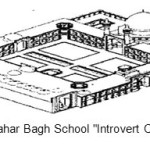 |
|
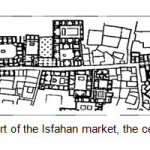 |
|
Spatial Proportions
Religious buildings have been built according to the proportion device regarding the specific and appropriate size. This can be seen in the design method of a building since the start of the project and the courtyard and the main spaces selection until the determination of the height and the proportions of spaces in decorating (Figure 4). This observation of the size and the proportions has caused the Islamic architecture to follow a specific standard called "Peimoun". Its beauty and balance is due to the observation of harmonious proportion devices (sectional conveyor, golden proportions and the like( Sltanzadh, 1985). This preferences and proportions can be seen in the mosques architecture in a way that the minor components are sacrificed in favor of the main components. In the past, traditional societies have employed two interconnected systems of sacred system and geometric system to regulate their environment. Nowadays, the technology-based systems have replaced the former systems without any connection with the spiritual needs and human will. They form the man lifestyle and demands (tahbaz, 2003).
Unitarianism
In terms of existence and awareness, the purposeful incentive of theorizing is related to the fundamental and unique government of the world which is the "principle of unity". Unity is important in human two general areas; the theorizing and all the thinking-oriented activities. These two areas are related to the relationship between the ontological aspect and the epistemological aspect of unity. It can be shown by the simple relation of the unity government in universe seeking unity in knowledge. Unity as a fundamental principle of being governs the human existence (Rappaport, 1998). The unity of space is defined for us in the body of religious buildings and the operating and the constructing system (Figure 5).
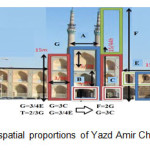 |
|
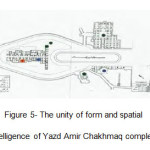 |
|
The Architecture of Precision and Clearness
Iranian architecture of religious buildings is a precise, clear and fluent architecture. This architecture with all of its internal complexities can be read and received at a glance. The whole scheme is available for audience. People are not confused and lost in it. There is always an elements or a sign to compare itself with it and find its place. The whole building and the spaces combination are clear and fluent without any twist, but, in spatial qualities and spatial meanings, it is mysterious and complex (Figure 6).
The Architecture of Integrity and Certainty
Iranian architecture of religious buildings is full of integrity, certainty, regularity and adornment. The geometric arrangement is available in all parts. The shapes, the spaces, the combinations, the facades, the surfaces, the volumes are in the complete geometric manner (Figure 7). The perversity and shortcomings, the approximation and uncertainty, instability as well as adornment, arrangement and integrity are clearly revealed. This arrangement is only in its form, composition, surface, spaces and volumes. The designer basis and criterion is designed-based in all decisions. In the following chart and table, the conceptual system diagram of Iranian-Islamic religious buildings is investigated.
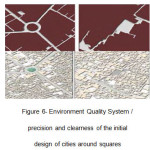 |
|
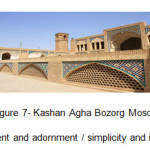 |
|
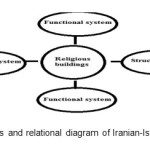 |
|
Table 1: Reviewing system of the Iranian-Islamic religious buildings architecture
|
Physical system |
Functional system |
Structural system |
Rate / sustainability |
|
visually identify |
Level of residence |
civiling |
Logic and Thinking |
|
loss, protrusion |
Privacy and spiritual values |
Open and closed / heavy spaces |
Creativity |
|
The central courtyard |
The communication system |
The structural complexity / unity in diversity |
Phenomenology |
|
Proportions |
Structural linguistics |
Related decorations / layout work, Muqarnas, ... |
Residence system |
|
Unity formal / formal creation |
Spatial intelligence |
Native materials |
The environmental comfort |
|
The effects of physical / environmental |
Visual-spatial coherence |
Integrated framework |
Cause and effect |
The Architecture of Simplicity and Impossibility (easy yet difficult to imitate)
The Iranian-Islamic religious buildings architecture is simple yet impossible (easy yet difficult to imitate) as Saadi expressed. It is deep and complex. Apparently, it is in the possible simplest form, but it has a lot of hidden conceptual layers and mysteries which cannot be understood without intimacy. It doesn’t desire the one-day lovers and does not reveal itself.
New Horizons Revitalization
The monuments and buildings remaining from the ancestors' behavior are the most effective means to understand the Islamic architecture spiritual and intellectual principles. Iranian architecture is the outcome of our goodwill ancestors' spiritual view. Therefore, whenever these works are reviewed, they can be the way to explore the concepts covered in their body. These concepts have been generated from Iranian and Islamic spiritual doctrines and have been extended in the material form. One of the most important doctrines of Islamic architecture is "Fana-fi-Allah"[1]. Iranian architect, by passing over the carnal desires, made himself out of centrality. His will have been replaced by God's commandments. By passing over his name (himself), the spiritual doctrines, not the personal tastes, are expanded in his art. With firm faith in the great God and the worthlessness of all other things, the Iranian architect architects along with people. Therefore, the result of action depends more on people beliefs and spirituality governing social lives and not the architect will (Iran Manesh, 2004). In Islamic architecture, everything goes back to an origin. It must be understood that these principles are not heterogeneous practically, but they are harmonic. This is called "wisdom" in architectural culture. This wisdom is the central point of the spiritual doctrines compatibility with physical needs and architectural tools and materials. The hidden geometry in Islamic architecture works arose from the system which put everything in its own place like a metaphor of the spiritual world. It gives everyone a status according to his competence. Continuity between the arts can lead the various and diverse parts of the world to a transcendental unity. In the golden age of Iranian Islamic architecture, this unity and coordination is crystallized in an ideal condition.
The unity among the arts went beyond the form of individual buildings. The architecture combined with the wisdom and Islamic art, all have one thing to say and that is witnessing the greatness of God. Based on the respect for the shared spiritual principles, all kinds of arts are homogeneous in their inner truth. These days, this doctrine is paid more attention by Iranian sympathetic architecture professors. To compensate for the insufficiencies of architectural education, some professors encourage their students to speak with other artistic fields. The continuity between poetry, painting, music and architecture is in such a way that, by relying on them, man can learn the secrets and the mysteries of the universe successfully (Iran Manesh, 2004) The thing which makes all these fields closer in Islamic culture, compared to other cultures, is the fact that all these fields have accepted the spiritual doctrines and the cultural beliefs as the basis for their growth and development. The most important Iranian architectural achievement in the manner of Islamic wisdom is the fact that if an architecture or an artist abandons himself and obeys the God's kingdom, the divine unity essence will penetrate in the body of his works and makes them dynamic and consistent to the extend in which they seems to be the members of a same body.
The buildings which indicate a premiere being, without mentioning the name of the architect, the individual interests and the group affiliation, can establish an effective connection with their audience. The connection which exists among the Islamic school works of architecture and their audiences is the result of a hidden spirituality which the architect left in his works unconsciously. This principle is one of the most effective doctrines of Islamic architecture. According to this principle, each architect listens to his conscience sound, instead of the audience demands. This kind of architectural work penetrates in the heart of every lover and leads him to the submission status since it is based on the innocent nature of a divine man.
The Realization Manner of the Wisdom Identity and the Islamic art in the Creation of Enlightening Architectural Work
According to numerous verses and narratives, the human nature is a potential issue and an inherent talent which is shared between all human beings. Human ideals will enjoy his divine nature when he brings his innate talents to his consciousness, intentionally and selectively. In addition, to present an identity-oriented work of architecture in terms of Islamic wisdom and art, the architect, in the first stage, must use a method based on practical wisdom of Islam (sharia) and obey the five precepts (obligatory and forbidden and detestable recommended, permissible) to step in wisdom path. In the next stage, the architect or the artist must have the required talent and experience in the art for his artistic ijtihad (effort) process to be realized. The artistic ijtihad (the inherent justice) means putting everything in its proper place through the required experience, architecture and talent and, finally, there is the creation of architectural art. Figure 9 explains this process and its various stages which are based on the principle of the separation of theoretical propositions, practical propositions and instances.
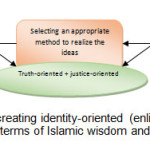 |
|
In the process presented above, the important point is that one can imagine a range of different degrees in each of the diagram three stages based on the achievement of the objectives of each phase. This range of different degrees causes the realization of diagram outcome (as the Islamic identity in architecture) to be relative. The Quran clearly states that the existence of different degrees in various aspects of human life is apparent: "We raise to degrees (of wisdom) whom we please: but over all endued with knowledge is one, the All-Knowing. " (Yusuf Surah, verse 76). Therefore, according to their degree of faith and understanding of the existence truths, the committed Muslim architects have different interpretations. Their work reflects the understanding degree of the existence stages. As a result, Muslim architects and their works are in a relative relationship with the religion content. There cannot be any absolute relationship with Islam, unless:
- First, the architect understanding of Islam, art and Islamic wisdom is perfect and absolute and not relative.
- Second, the architect creativity and knowledge is perfect enough to create a work of art which is entirely appropriate and consistent with his understanding.
Indeed, the first case is the absolute perfection in religion recognizing and understanding which exclusively belongs to Masumin (innocents) and no one else. The second case is the perfection in practice and implementation which is relative and credit inherently. At the third stage of the diagram, it should be noted that God has not given the talent of doing anything to anyone. Some people are good architects; some are more talented in poetry and so on. Therefore, the result of this step is a relative and credit matter.
Obviously, according to religious teachings, the realization of absolute perfection in each mentioned stage is not possible for anybody except the Masumin. In 45th letter of Nahjolbalaghe, Imam Ali has stated that "Certainly, you cannot do so but at least support me in piety, exertion, chastity and uprightness". Therefore, the works resulted from the Muslim architect creativity are not absolutely based on religion content. The theory which considers some architectural monuments of Islamic civilization, such as Dome of Imam Mosque in Isfahan, as the physical manifestation of Islam, is an extremist view. These works are not the physical manifestation of Islam in an absolute manner. The second theory which is a conservative theory is based on the fact that there is no relationship between architecture of Islamic civilization or Islamic architecture and Islam and Islamic identity. They are different in terms of objective and tool. As explained above, it should be acknowledged that, according to Islamic teachings, the absolute rejection of the relationship between Muslims works of art and Sharia is basically defective. The Qur'an does not reject the possibility of achieving the heart and essence of Islam. It is stated that everyone can achieve the depth and truth of Islam according to his purity of heart and spiritual refinement: "Which none shall touch but those who are clean" (Al-Waqia Surah, verse 79). The principle indicating the relationship and correspondence between Muslims actions/ works of art and Islam is an accepted principle in Qur'an. The strengths and weaknesses of this relationship are according to the degree of heart purity and have various degrees.
Accordingly, at each stage of spiritual evolution, the works of art are appropriate to the same stage. This is the belief in a relative relationship between Muslims works of art and Islamic identity. Whenever the architect employs the lower stages and descended souls (Solid, plant or animal soul), his work of art is as the same degree with the soul content. If an architect or an artist abandons himself and obeys the God's kingdom, the divine unity essence will penetrate in the body of his works The body of his work of art will be appropriate to higher levels of life (intellectual and spiritual souls). This is the realization of Islamic art and wisdom identity in creation of enlightening architecture.
Conclusion
Islamic architecture, as one of the richest art this land, is the memorial of our pure (innocent) ancestors. It is full of doctrines which are doubtful in present day. Obviously, what makes this Iranian Islamic architecture is the wisdom governing the soul of this architecture. After reading a few of the thousands of Iranian-Islamic architecture mysteries, it can be realized that the architecture has an earthly form and a spiritual character. All aspects of the human life must be searched in architecture. According to Mulla Sadra who has called the art the “delicate craft”, these crafts are mysticism, diversity in unity, unity in diversity, logic, the principle of worship, continuity, open and close space link, sobriety and moderation, form and color, delicacy, companion with handwriting, empathy with water, preference, clarity and naturalness, integrity and certainty and simple while being impossible. They make a spiritual structure for identity-oriented architecture. To avoid multiplicity in the modern city, the concepts and skills of past buildings are needed. They can lead the cities physical environment to Iranian and Islamic identity-oriented architecture. With a comprehensive look, Islamic architecture is a media which reveals its creators spiritual insight for its current visitors. Spirituality and spiritual beliefs of architect are the capital which paves the way for connecting to the source of divine grace. Divine favors make the man transcendental and provide the comfort and prosperity for him. Islamic spirituality and technical principles of Iranian architecture have reached the transcendental wisdom. This wisdom answers the needs of the material world as well as the spiritual needs of the supernatural world. Accordingly, it can be said that if an architect or an artist abandons himself and obeys the God’s kingdom, the divine unity essence will penetrate in the body of his works.The body of his work of art will be appropriate to higher levels of life (intellectual and spiritual souls). This is the realization of Islamic art and wisdom identity in creation of enlightening architecture.
References
2. Avani, Reza. “Wisdom and spiritual art,” Gross Publications, Tehran, 1995..
3. Nasr, Seyyed Hossein. “” Islamic tradition in Iranian architecture “in the immortality of art”, translated by Mohammad Evin Leaves Azeri, Curr. World Environ., Vol. 10(Special Issue 1), 990-1001 (2015) 1001 Publications, Tehran, 1990.
4. Issues, S.. “Housing Plan as a result of religious beliefs in traditional Iranian desert”, Journal of Fine Arts, No. 37, 2008.
5. Kuhnel, E., “Islamic Art and Architecture”, G. Bell and Sons LTD, London, 1966.
6. Grabar, T., “The Formation Of Islamic Art”, Yale University Press, Oleg New Haven, 1993.
7. Michel, G., Thames, A., “Architecture of the Islamic World”, Hudson Press, London, 1984.
8. Kosh,e. “Mujhal Architecture, noutline of its History and Development”, 1526-1858, Prestel publication, Munich, 1995.
9. Mahdavinejad, MJ. “Searching the deep structure of intellectual wisdom of Islamic architecture Islamic architecture”, Journal of Fine Arts, No. 19, 2003.
10. Wilber, D., “The Architecture of Islamic IRAN”, Princeton University Press, 1995.
11. Nasr, Seyyed Hossein. “Sadra Shirazi” in “History of Islamic Philosophy”, to try Mohammed Sharif University Publication Center, Tehran, 2006.
12. . Rabie, Hadi. “Queries in the nature of Islamic art (overview of the history of Iranian architecture / Kambiz Haji Ghasemi)”, Tehran, translation and publication artwork, text, 2008.
13. rahnavard, Zahra. “Wisdom of Islamic Art”, Tehran: the study and formulation of Humanities University (left), 1998.
14. Nasr, Seyyed Hossein. “Islamic Art and Spirituality”, translated Rahim Ghasemian, Religious Studies Department of Art, Tehran1995.
15. Noghrekar, Abdul. “Introduction to Islamic identity in architecture and urbanism”, broadcast radio messages, Tehran, 2007.
16. MotahariMorteza. “Collected Works”, Volume 6, publishing Sadra, Tehran, 2008.
17. . Burkhard, Titus. “Sacred Art”, translated by J. nursing, Third Edition, published by Soroush, Tehran, 2001.
18. Sltanzadh, Hussein. “The process of formation and religious center of the city”, printing, publishing aware, Tehran, 1985.
19. Atyng·havzn, Richard. And Grabar, Oleg. “Islamic art and architecture”, translated by James Azhand, Publication, Tehran, 2001.
20. tahbaz, M. “Footprints in the sanctity of Islamic architecture”, magazine pages, No. 39, martyr Beheshti University, Tehran, 2003..
21. Rappaport, Amos. “Cultural Complex biological origin”, translated by R. Zadeh, University Road University of Science and Technology, Tehran, 1387.
22. Iran Manesh, MA. “Queries on the definition, description and much theory”, Journal of Architecture platform, No. 41, Tehran, 2004.
23. Pirnia, Mohammad Karim. “Introduction to Islamic Architecture”, edited Memarian.R GH, University of Science and Technology, Second Edition, Tehran, 1992.






